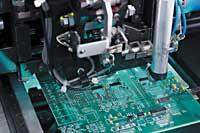UMTS against WiMax

Voice, image and high-speed Internet access is what the third generation of mobile telephony offers. The first generation was analog, based on ETCS and TDMS standards. The second generation of mobile phone is the most widespread today, started with GMS and completed GPRS. The third generation announced the telecommunications revolution and comes with three years of delay and unresolved many doubts. Universal Mobile Telecommunications System is the name of the standard, abbreviated UMTS.
The sale of UMTS licenses has mobilized millions of euros. In Europe, large telephony companies have spent nearly €200 billion on buying local licenses. Basically, the UMTS is a set of technologies that enable high-quality multimedia wireless communication. This third generation mobile phone standard aims to solve compatibility problems between the systems currently in force. It is also intended to increase the speed of data transmission to address the problems of saturation of the GSM network and to be able to perform multimedia telephony.
Telephone companies have announced that data transmission can reach a speed of 2 Mbps in the UMTS system, but in principle it will be less than 384 Kbps and the actual speed will depend on network deployment, the degree of access servers. However, it seems to be better than what the Residential ADSL offers, that is, more than 256 Kbps and six times faster than the second generation GPRS system.
This speed is sufficient to provide good quality Internet access and to offer mobile a large multimedia capacity, such as video conferencing, video downloads, games, etc.
Constantly connected

A special feature of the UMTS system is its permanent connection to the network. Therefore, payment will not depend on the connection time, but on the amount of data processed.
It uses terrestrial, wireless and satellite links and is designed to work worldwide. Network changes are made instantly and uninterrupted. Austria, Sweden, Denmark, the UK and Italy already have the UMTS system in place. They have recently been launched in Germany and France. Telefónica and Vodafone have put their first services in Spain and will be expanding soon. They have already installed 2,000 antennas, which in ten years will exceed 20,000.
One of the problems of the UMTS system is the large size of mobile phones. Those presented to the first market have a price of between 100 and 200 euros and are too large to carry in the pocket, they are heated and the battery is sold out easily. But as with second-generation phones, smaller, lighter and longer lasting phones will soon arrive.
Today, 1 billion people worldwide use mobile telephony. In early 2005 it is expected that 5 million will already circulate with the UMTS system and that by 2006 it will be 100 million.
But mobile, mobile, or motive is more than just a phone. It is also a photo camera, a tool capable of sending and receiving empty text messages (SMS) or multimedia (MMS). The tones, logos and the exchange of images to change the design of the screen have already become an important source of revenue for telephony companies. The UMTS system will greatly increase this multimedia capacity and will allow sending and receiving content over the network much faster. Photos and videos can be taken and sent instantly to anywhere in the world.
It was designed for GSM voice communications, GPRS provided data transmission capability (although it did quite slow) and now UMTS has made it possible for all these options to be made faster and simultaneously. It allows you to watch videos and audios as they arrive through the streaming system.
WiMax, the new generation of wireless networks
UMTS has been and is the great challenge of large telecommunications companies in recent years. But, when they realize it, they start creating a competition they didn't expect. The new technologies that are coming from the computer world can question the circular business that telephony companies foresee. For telephony companies, the number of the beast also ends with a 6: It is 802.16 and is called WiMax.

If WiFi has released wireless networks, it seems that with what they have named WiMax the large connection fields will become completely normal. Hot spots or network access points that will generate WiMax technology will be elevated. Your limit will be 70 Mbps transfer speed. But if that were not enough, the size of the territory that a Hot Spot can cover will not have to do with the 300-400 meters that the most advanced versions of the WiFi so far had as limits. With WiMax you will be able to offer the net within a radius of 50 kilometers, enough to cover quietly a small large town.
802.16 is the number of the new wireless data transmission protocol. This is 70 megabits per second bandwidth, seven times higher than current WiFi technology. But WiMax will not only reject WiFi. It also poses a major threat to the third generation of mobile telephony. In addition to offering a better service than UMTS, the implementation of such a network is much cheaper.
Behind WiMax there are 67 powerful companies, including Intel, Nokia, Siemens and Fujitsu. WiMax delves into the path that opened WiFi. That is, it acts on unregulated wavelength, so unlike GSM or UMTS mobile phone systems, it has simpler legal requirements. In addition, the installation is much cheaper than the UMTS. The installation of a basic WiMax access can cost between 5,000 and 25,000 euros, in exchange for offering 200 connections as the current ADSL technology. A small investment will be enough to deliver voice and bandwidth to the entire city.
Autumn 2005 may be the day this amazing WiMax is available. However, the data usually presented when selling the products are at most. That is, they show the limitation of these tools in the best conditions. Subsequently, in practice, the results are usually much smaller. For example, the installation of a WiMax access in the city center would theoretically imply that its influence would reach 50 kilometers, but in practice, surrounded by buildings, the signal is attenuating and does not reach so far.
In two or three years, laptops and PDAs will be ready to connect to WiMax networks. Nokia and Siemens have already started working on the development of phones capable of connecting these networks with mobile phones.

But until they arrive, the WiMax system needs a small lifting antenna to work. In order for the first commercialized systems to work, this antenna must be installed outside the buildings. The ultimate goal is to launch computers that will be ready to access the WiMax network without installing the antenna, as easy as plugging the current WiFi card into the computer.
The telephone company also alerts
Being a tool capable of transmitting 70 megabits per second and covering 50 kilometers of radius, why copper wires? What today breaks competition between telecommunications companies is their ability to bring the network to every home. Telefónica's hegemony in Spain is based on this, since the copper threads are integrated from the PBX to the kitchen of each citizen, which offers an insurmountable advantage in market competition. To cope with this, Euskaltel is making a great effort to bring its threads to all homes. The WiMax system can break this monopoly and turn what until now was pasture for big business into a space open to competition for small and medium enterprises.
With WiMax the molds of the computer world will be introduced into the telecommunications playing field, which can alter the forms of play so far. Some experts believe that governments will hinder the expansion of WiMax driven by TV companies. On the other hand, WiMax offers an excellent opportunity to spread the Internet in rural areas.
In short, they serve to communicate, speak, exchange writings among people. But in the face of emerging technologies, tools, electronic systems, wireless networks, etc., you sometimes run the risk of forgetting what your goal was. And that remains the same: communication. Between Sonia and Iñaki, Olatz, José Juan and Enrique, communication between men and women. That was the goal. Of the companies that have helped us to equip ourselves with infrastructure and to transform the desire in needs to be able to offer the opportunity to do it in any place and conditions… to earn money, of course.





